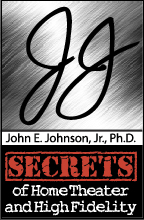Bryston Middle T Floor-Standing Speakers Review Highlights
Bryston, long known for their massive power amplifiers, has branched into marketing speakers. One of their first models is the Middle T, reviewed here, which is a three-way floor-stander.
The Middle T has a 1″ metal dome tweeter, 5.25″ midrange, and two 8″ woofers. The crossover frequencies are 160 Hz from the woofer to the midrange, and 2.3 kHz from the midrange to the tweeter.
At 40″ high and 81 pounds, it’s a floor-standing speaker, but not so large that it overpowers a room with its physical presence.
On the audio side however, this is definitely a heavyweight. It produces a huge soundstage, very low fall-off at off-axis listening posistions, and a flat frequency response down to 20 Hz. You read that correctly: 20 Hz. This is one of the only speakers I have ever tested that does well in the bench tests at 20 Hz. So, you don’t need a subwoofer (that doesn’t mean you can’t add a couple of subs to blow the windows out with movies if you wish).
I was simply amazed at the sound. Bryston didn’t cut any corners when they designed the Middle T. However, they did add some angled (not-900) corners on the enclosure to minimize parallel surfaces that would cause standing waves inside. A rap with the knuckles on the enclosure indicates heavy damping, which minimizes resonance.
You can choose real wood veneer or vinyl finish in the same color, which will reduce the price a few hundred dollars. Frankly, with spouses tending to want to put potted plants on speakers, I would go with the vinyl, which won’t stain from any moisture from those pots. Vinyl covering on speakers has improved so much over the years, it is nearly impossible to see any difference between vinyl and real wood.
The Bench Tests were astounding, showing low distortion and wide dispersion without much fall-off.
Bryston Middle T Floor-Standing Speakers Highlights Summary
- Excellent build quality
- Produces high SPL with low distortion
- Flat frequency response down to 20 Hz
- Excellent off-axis response
- Choice of real wood veneer or vinyl (to save a few hundred dollars)
Introduction to the Bryston Middle T Floor-Standing Speakers Review
I have reviewed many Bryston products as Editor of Secrets, in fact, over as long a period as they warranty their amplfiers (20 years). I have never been disappointed in the results, and I always hated having to send them back after the review. Some examples of my reviews include the BP17 Stereo Preamplifier, and the BDA-2 DAC.
I especially hated having to lift the power amps into the boxes, and lift them again onto the loading area for pickup, which usually resulted in the need for a deep tissue massage later that day. I watched, with tears in my eyes as the muscle-bound 5’4″ female UPS driver easily hoisted them onto her truck, and I waved bye-bye as she drove away.
As is with most successful companies, Bryston wanted to expand their product line, so they decided to venture into speakers. But not just another speaker. They planned carefully, wanting specific performance, such as low fall-off when sitting off-axis. That in itself is tough to accomplish, and I was shocked at how successfully they achieved it, because at first glance, the Middle T doesn’t look much different than other similar sized speakers.
Looks can be deceiving though, and in this case, they are. Looking at the top of the speaker, one will notice that the enclosure edge first turns outward by about 150 , and then inward by the same amount. This reduces the number of surfaces that are parallel, therefore, also reducing the tendency for standing waves developing during playing.
SPECIFICATIONS of the Bryston Middle T Speakers
- Design: Three-way, Ported Enclosure
- Drivers: One 1″ Metal Dome Tweeter, One 4.25″ Polypropylene Midrange, Two 8″ Polypropylene Woofers
- MFR: 33 Hz – 22 kHz ± 3 dB
- Crossover Frequencies: 160 Hz, 2.3 kHz
- Nominal Impedance: 4 Ohms
- Sensitivity: 88 dB/1 Watt/1 Meter
- Dimensions: 39.5” H x 10.5” W x 16.5” D
- Weight: 81 Pounds/each
- MSRP: $5,300/pair USD; Black Ash, Natural Cherry, Boston Cherry Wood Veneer, $6,200/pair Rosewood Veneer; $4,695/pair in Vinyl
- Bryston Audio
- Tags: Bryston, Speakers, Floor-standing
The Design of the Bryston Middle T Speakers
When Bryston set out to design their new line of speakers, they had several goals in mind: (1) High levels of SPL without distortion or compression; (2) Unit to Unit matching; (3) Bryston internal crossovers, designed to integrate perfectly with Bryston Amplifiers; (4) Custom designed drivers with die-cast aluminium baskets, substantial magnet assemblies, and custom motor systems; (5) Wide dispersion design; and (6) Engineered to prevent cabinet resonances.
They also wanted to have them built in North America. SInce Bryston is a Canadian company, they contacted Axiom Audio, which is also Canadian, and who have their own factory.
![]()
So, Bryston went through many prototypes, and finally came to the stage where they were satisfied with the results. The Middle T is one of fifteen models that are now available, including larger floor-standers, bookshelf monitors, center channel speakers, and subwoofers, as well as in-wall and on-wall speakers. That’s quite an investment, so they were very careful, and the results speak for themselves, literally.
The Middle T has a 1″ titanium dome tweeter, one 5.25″ midrange driver, and two 8″ woofers. The grilles attach using neodymium magnets (very strong), with the magnets on the enclosure being underneath the veneer, so they don’t show when you have the grilles off. I love to look at the drivers on a speaker and always use them without grilles (unless they are planar magnetic, in which case, the grilles are not removable, or, in the case of electrostatics, which don’t have grilles).
![]()
Two large flared ports are on the rear of the speaker, along with a set of five-way speaker binding posts with a bus bar that allows bi-wiring or bi-amping. The ports have creases along the edges to reduce port noise.
![]()
![]()
“Outrigger”-style feet come with the speakers, but I did not use them because the speakers were sitting on a wall-to-wall carpet.
The Bryston Middle T Speakers In Use
I tested the Middle T’s with an OPPO BDP-105 universal Blu-ray player, networked through a USB hard drive and iPad app, Pass Labs Xs preamplifier, and Pass Labs Xs-300 monoblock power amplifiers. Cables were Wireworld.
I started out with the speakers 8 feet apart, sitting at a slight toe-in towards my chair, which was 10 feet away.
Now, I’m not going to get into hackneyed statements, like, “It sounded as if a veil was lifted,” or, “They sounded like speakers costing much more.” Those wore out in the 20th century.
Straight and simple: The Middle T’s had a very neutral sound, surprisingly more so when I faced them straight into the room instead of toeing them in (see Bench Tests), with amazingly low distortion at loud levels, and shockingly low bass that I never would have expected from a full-range speaker 40″ high. The sound is also highly detailed, with a very wide soundstage, probably due to the wide dispersion and its increased reflection from walls (a room can enhance the sound; it isn’t always a detraction).
Let’s start out with some music that I downloaded from 2L in Norway. It’s 24/192, and I downloaded both the stereo version and the multi-channel version. For this test, obviously I used the stereo version. It’s called “Hymn to the Virgin”, 2L-095.

This is a gorgeous album, recorded in DXD (Digital eXtreme Definition), which is 24/352.8 PCM, and then transcoded to several formats for download, including 24/96 PCM, 24/192 PCM, DSD64 (standard SACD format), and DSD128. I preferred the 24/192 over the DSD128, but it’s not a fair comparison, because the DSD128 was not native DSD. It was converted from the DXD PCM master. It’s difficult to know which SACDs that we purchase are native DSD, and were not PCM to start with, nor converted to PCM for editing, or if they were native DSD, but converted to PCM for editing, and then converted back to DSD for disc mastering.
Here is a spectrum of the first track, by Benjamin Britten, “A Hymn to the Virgin”. You can see that there is musical signal well into the 40 kHz region. Although the Bryston speakers didn’t reproduce those high frequencies, 24/192 does more than just extend the frequency response. It improves the sound in the audible spectrum. The Brystons reproduced the choir as if it were in my listening room. Just breathtaking.
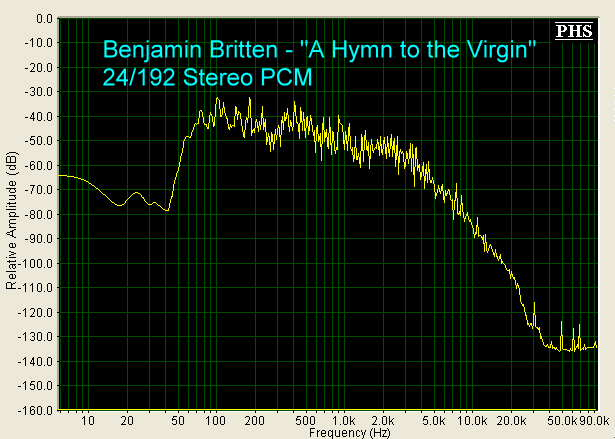
J.S. Bach’s Brandenburg Concertos, played by the Dunedin Consort, conducted by John Butt, is another 24/192 download. The dynamics were marvelous through the Brystons, and the stringed instruments were as clear as a fine glass of chenin blanc.

There has been some discussion on the web about whether this album started out as 24/96 and then was up-converted to 24/192. The spectrum of the first movement of Concerto No. 1, shown below, indicates to me, that it is native 24/192. Notice that there is musical signal at 50 kHz (the peaks are electrical noise, but the slope indicates signal, and I saw this region moving while playing the music through the analyzer). This would not be the case if the original recording were 24/96.
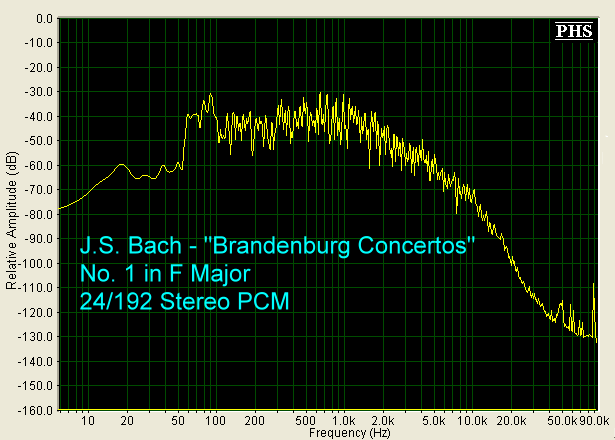
Copland’s Fanfare for the Common Man is my go-to music track to test just about any component I have in the lab that would show problems at the lowest octave, as well as some loud gong crashes that stress tweeters. This version, on Telarc, is an SACD conversion from the original 16/50 PCM master, and is one of Telarc’s first digital recordings. It set the stage for Telarc’s reputation for producing CDs with no compression. So, their recordings are very dynamic, and have deep bass when it’s in the musical score. The album is Telarc SACD-60648.
The Bryston’s held their own with the huge bass drum that is used in this piece. That was one of the six requirments for Bryston, as listed at the beginning of this review. The Middle T’s are one of the only speakers I have ever tested that really don’t require a subwoofer. Amazing. Absolutely.

The Bryston Middle T Speakers On the Bench
For distortion measurments, the test microphone was placed 1 foot from the respective driver. For the low frequencies, the microphone was pointed between the two 8″ woofers.
At 20 Hz, and 90 dB output, distortion was less than 10%. This is a number that many dedicated subwoofers cannot produce.
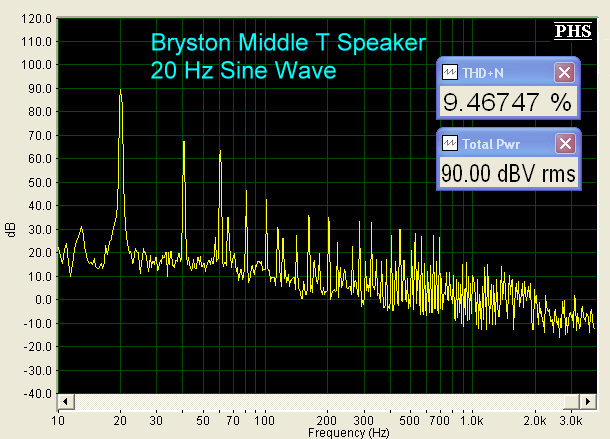
The ports are tuned to 28 Hz, so the test at 25 Hz showed 21% THD+N. At this frequency most of the sound is coming from the rear ports. However, we listen to music from the front, so I measured it that way, and the speakers were 6 feet away from any wall. In your home, the speakers would likely be a foot or so out from the wall, and the bass from the ports would reflect from the wall. Distortion at 25 Hz and 90 dB in front where you sit, taking into account the wall reflection, would likely be midway between what it would be at 20 Hz and 30 Hz.
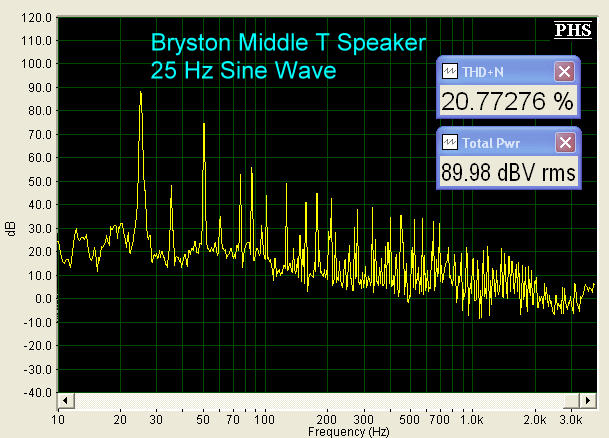
At 30 Hz, distortion was less than 5%, which, again, is excellent.
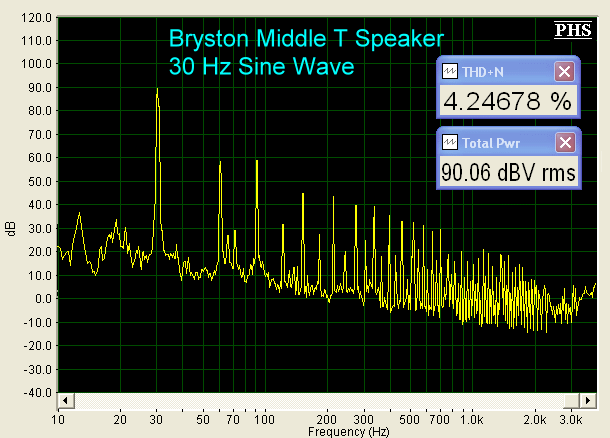
A 40 Hz test signal produced only 1.2% distortion.
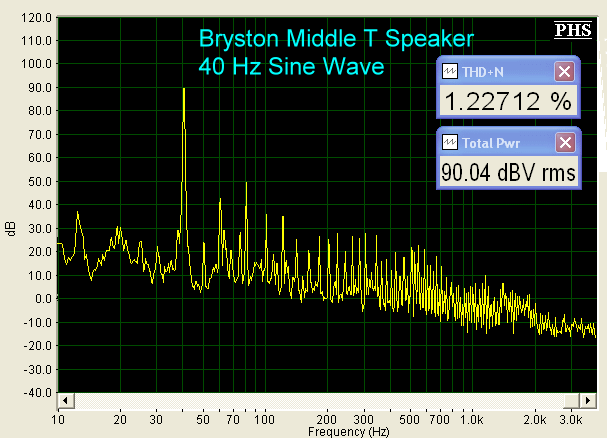
And at 50 Hz, less than 1%.
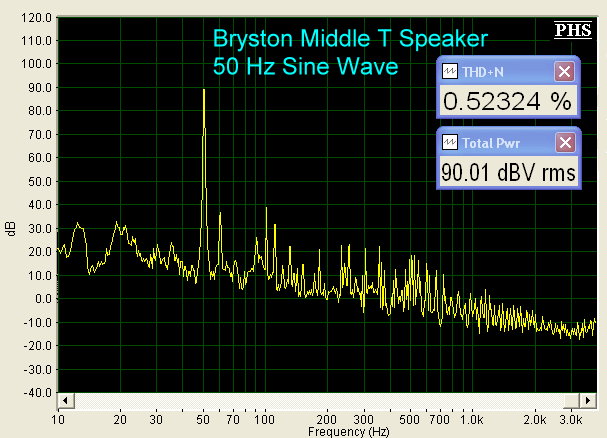
So much for the woofers. Let’s move on to the midrange driver. At 1 kHz, distortion was less than 1%.

And for the tweeter, a 10 kHz test signal. Distortion was really low, at 0.3%.
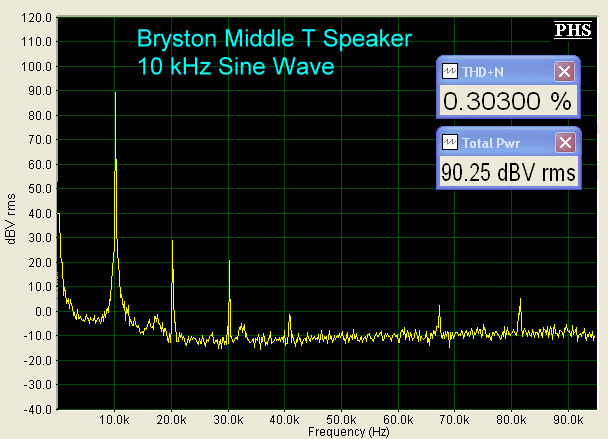
The room frequency response, at 2 meters, is shown below. First is an on-axis response, and then a 450 off-axis response. You can see that the off-axis response attenuates some of the very high frequencies above 18 kHz, but the midrange comes up a bit, actually making the overall response flatter. So, I would suggest not toeing in these speakers, as the sweet spot is off-axis, in my opinion. Since my favorite listening chair is off-axis, that’s just fine with me.

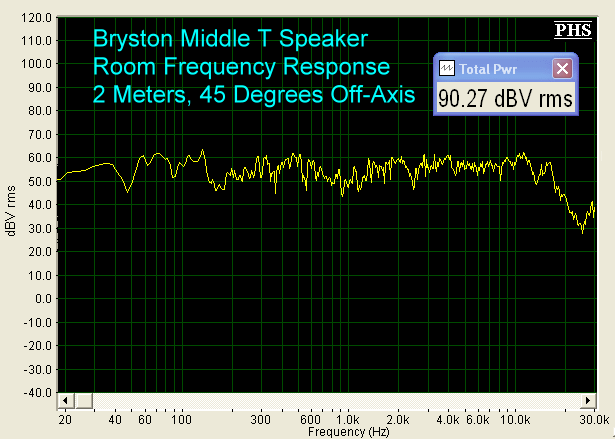
The impedance/phase plot is shown below. The impedance spread would suggest the Middle T to be a nominal 8 ohms rather than the 4 ohms specified (Bryston tends to be conservative). This is a very easy speaker to drive. The phase is + 300 to – 100, which is very good performance.
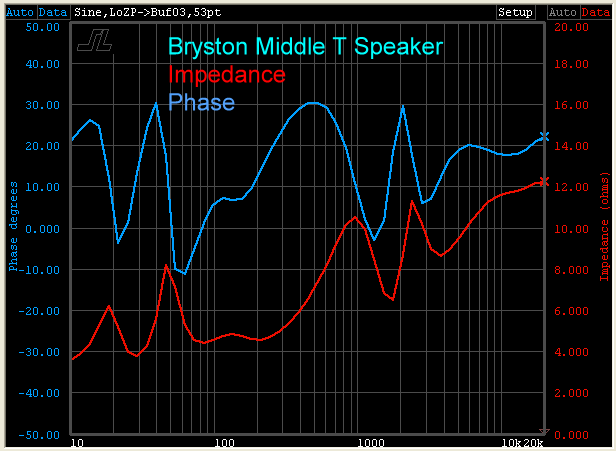
Conclusions about the The Bryston Middle T Speakers
I expected no less from Bryston than to produce speakers worthy of their fine preamps and power amplifiers. If I were building a home theater system around these, I would use three across the front, with a screen that is transparent to sound, or set the screen up so that it does not have to come closer than 40″ to the floor, and two in the rear, with on-walls or bookshelf monitors on the side.
The Middle T’s are a terrific product.



